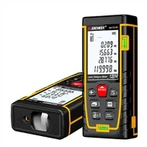Steps to use the clamp meter:
1. Correctly select the clamp ammeter according to the type and voltage level of the measured current. Generally, for the line below 500V AC, use the T301 type. When measuring the current of a high-voltage line, a high-voltage clamp-on ammeter that matches its voltage level should be selected.
2. Correctly check the appearance of the clamp-type ammeter, whether the closing of the jaws and the condition of the meter head are normal. If the pointer is not at the zero position, the mechanical zero adjustment should be performed.
3. Select the appropriate clamp-type ammeter range according to the measured current. The selected range should be slightly larger than the measured current value. If you do not know the size of the current to be measured, you should first use the maximum range to estimate.
4. Correct measurement. When measuring, press the wrench tightly to open the jaws. Place the conductor under test in the center of the jaws, loosen the wrench and close the jaws tightly.
5. After reading, open the jaws, withdraw the tested lead, and set the gear to the highest current or OFF gear.

Measurement example: measure the working current of a squirrel-cage asynchronous motor in operation. According to the size of the current, it can be checked and judged whether the working condition of the motor is normal, so as to ensure the safe operation of the motor and prolong the service life. First, select the voltage level of the clamp-type ammeter correctly, check whether the appearance of the ammeter is good, whether there is damage, whether the pointer swings flexibly, and whether the jaw is rusted. Estimate the rated current based on the motor power to select the range of the meter. When measuring, it can be measured once for each phase, or once for three phases. At this time, the number on the meter should be zero (because the sum of the three-phase current phasor is zero). When there are two phase wires in the jaw, the meter will display The value is the current value of the third phase. By measuring the current of each phase, it can be judged whether the motor is overloaded (the measured current exceeds the rated current value), whether there is a problem with the motor or the power supply voltage, that is, whether the three-phase current imbalance exceeds 10%. limit.





